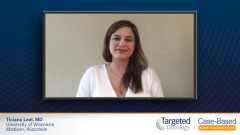
Evaluating Current Treatment Options for Small Cell Lung Cancer
Dr Ticiana Leal, MD, highlights the approvals of new regiments in small cell lung cancer. However, she discusses the struggles physicians currently face, such as identifying predictive biomarkers used to select patients who may respond well to new treatment regiments.
Episodes in this series

Ticiana Leal, MD: We’ve made progress and had approvals of new regimens in small cell lung cancer, which has been great to see and great to be able to provide new therapies and new hope for small cell lung cancer patients. One of the questions that remains is the role of predictive biomarkers in selecting patients most likely to benefit from strategies such as chemotherapy-immunotherapy. That is something we’ll need to work more on as the new trials come out. The other important thing to work on is improving cure rates in the limited-stage setting. Patients with limited-stage disease are receiving chemotherapy radiation in combination with platinum-etoposide, and it’s going to be exciting to see if adding immunotherapy to chemotherapy radiation will improve the outcomes and cure rates for patients with small cell lung cancer in the limited-stage setting.
I’m also interested in seeing more about the molecular subtypes of small cell lung cancer. We saw some interesting results from Dr [Taofeek] Owonikoko at ASCO [American Society of Clinical Oncology Annual Meeting] showing that patients with YAP1 expression seemed to have an inflammatory signature, and perhaps these patients are most likely to respond to immunotherapy. Lastly, I’m also interested in looking at PARP inhibitors and the SLFN11 story to see if this is a biomarker that will help select patients for therapies. I’m interested in seeing the combinations of PARP inhibitors and immunotherapy in small cell lung cancer and what kind of outcomes and improvements we can see in that.
Lastly, I’m really interested in seeing CAR [chimeric antigen receptor] T-cell therapy targeting DLL3 and if that will show some promising and interesting activity in small cell lung cancer. There’s a lot of work to be done. We certainly have seen improvements with the addition of immunotherapeutic chemotherapy in the frontline setting. We are seeing what appear to be clinically meaningful benefits with the addition of lurbinectedin in the second-line setting. But we need to have more studies showing better outcomes and greater and meaningful benefits for patients.
In terms of 1 of the ways to answer all these questions, 1 of the important things for all of us treating patients with small cell lung cancer in the community or academic centers is to continue to work together and try to enhance and increase accrual of patients to clinical trials. [Then we can] get the clinical trials completed and have these answers for our patients. Thank you very much.
Transcript edited for clarity.
Case: A 61-Year-Old Man With Small-Cell Lung Cancer
Initial Presentation
- A 61-year-old man presented with a cough, fatigue, progressive shortness of breath
- PMH: unremarkable
- SH: 25-pack year smoking history; social alcohol use
- PE: Right lower lobe wheezing on auscultation, axillary lymph node enlargement
Clinical Workup
- Labs: WNL
- Axillary lymph node biopsy revealed small cell carcinoma
- Chest/abdomen/pelvic CT showed a 7.1 cm mediastinal conglomerate mass, with invasion into the right main and lobar pulmonary arteries; 2 small left pulmonary nodules; hypermetabolic axillary lymph node
- PET scan showed large focal hypermetabolic activity in the mediastinum and small hypermetabolic activity in the surrounding area
- Contrast‐enhanced MRI of the head showed no brain metastases
- Stage IV small-cell lung cancer; ECOG PS 0
Treatment
- Initiated carboplatin + etoposide + atezolizumab for 4 cycles; followed with atezolizumab as maintenance therapy
Follow-up
- 7 months after starting treatment he complained of shortness of breath, right upper quadrant pain and back pain
- CT showed hematogenous metastases in the liver and right adrenal gland
- Initiated lurbinectedin 3.2 mg/m2 IV q21 Days







































